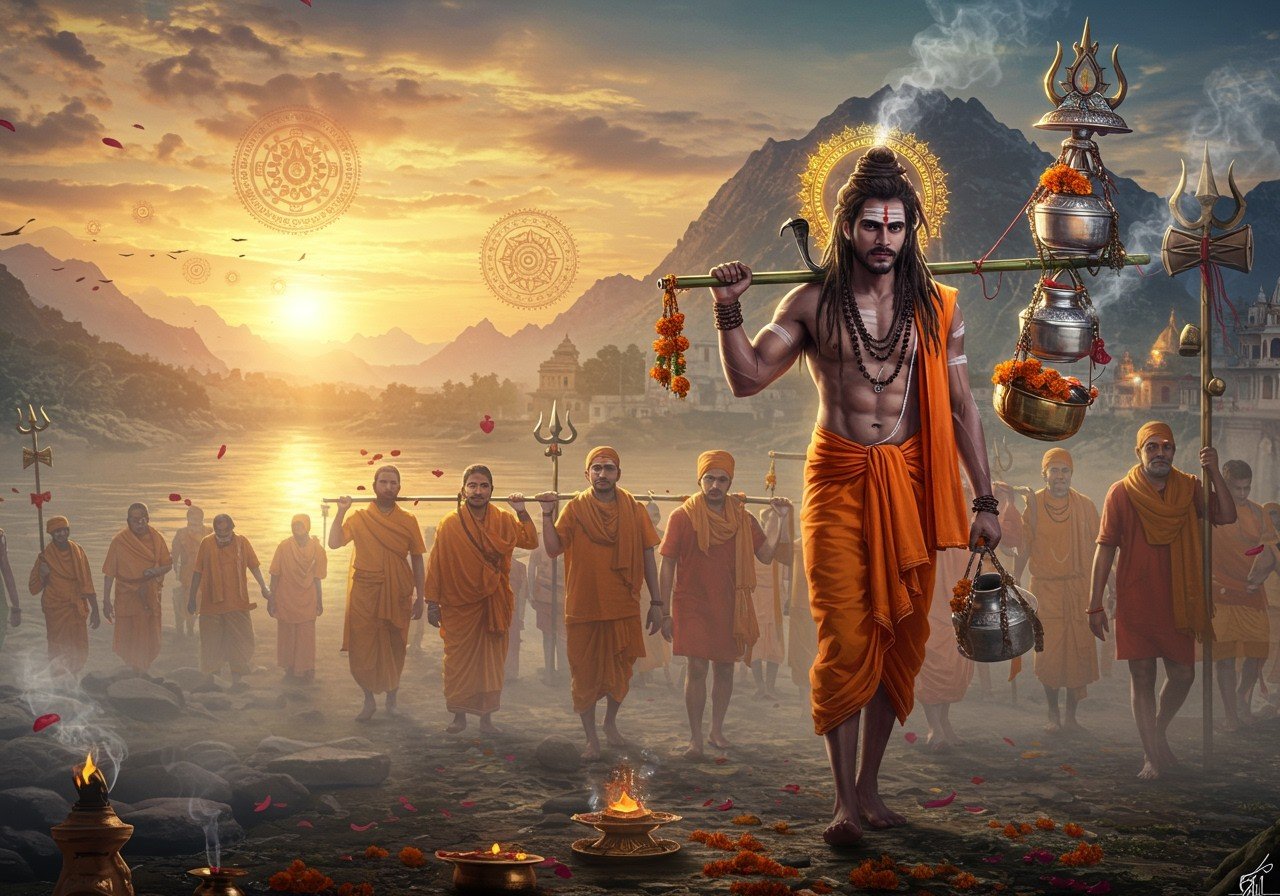
The Kanwar Yatra is a deeply significant pilgrimage for Hindus, dedicated to Lord Shiva. Observed during the holy month of Shravan (typically July-August), this sacred journey involves carrying holy water from the Ganges or other sacred rivers to offer at Shiva temples. As we approach Kanwar Yatra 2025, let’s delve into the rich history, cultural importance, and rituals that make this ancient tradition so special for culturally rooted Indians who cherish their heritage.
A Look Back: The History of Kanwar Yatra
The origins of the Kanwar Yatra are steeped in ancient Hindu mythology, tracing back to the Samudra Manthan, the churning of the cosmic ocean. Legend says that Lord Shiva consumed poison to save the world, and the Kanwar became a symbol of devotion, commemorating this selfless act. References to this sacred practice can be found in ancient scriptures like the Puranas and epics like the Ramayana. What began as a local tradition has blossomed into a grand cultural phenomenon, with regional variations across India, showcasing its profound impact. Through the ages, rulers and dynasties have supported the yatra, and while the colonial era and modern developments have influenced its organization, the pilgrimage has seen a resurgence thanks to improved infrastructure and wider media coverage.
The Heart of the Matter: Significance of Kanwar Yatra
The Kanwar Yatra holds immense spiritual and cultural weight for millions. It’s more than just a ritual; it’s a powerful expression of devotion to Lord Shiva, a deep spiritual connection. This pilgrimage is a personal journey of self-purification, penance, and seeking blessings, a chance to cleanse oneself and start anew. It unites people from all walks of life, fostering a sense of community and shared purpose. The yatra’s vibrant traditions keep our cultural heritage alive, and it also provides economic benefits to local communities through pilgrim tourism. While environmental concerns exist, efforts are underway to ensure sustainable practices.
The Why Behind the Walk: Reasons for Undertaking Kanwar Yatra
The motivations for undertaking the Kanwar Yatra run deep, grounded in faith and spirituality. Devotees often make vows or seek divine intervention for their well-being and that of their families. The Kanwar itself is seen as a vessel of faith, carrying sacred water as an offering to Lord Shiva. This journey symbolizes the path of life, filled with both trials and triumphs that ultimately lead to spiritual growth. It offers a time for introspection, building mental fortitude, and connecting with a tradition passed down through generations. It’s also an act of gratitude, a way of giving thanks for blessings received.
Decoding the Devotion: Meaning of Kanwar Yatra
The Kanwar Yatra is a profound display of reverence for Lord Shiva, observed during the auspicious month of Shravan (usually July-August). Devotees carry sacred water from the Ganges, believing it has the power to purify their souls and grant their wishes. This pilgrimage echoes ancient mythology, harking back to the churning of the ocean of milk (Samudra Manthan), where Lord Shiva swallowed poison to protect the world. The yatra symbolizes this act of sacrifice, representing the removal of negativity and embracing purity.
Sacred Steps: Rituals of Kanwar Yatra
The Kanwar Yatra is filled with meaningful rituals, each carrying its own significance:
The Kanwar: More Than Just a Vessel
Devotees, often called Kanwariyas or Bhole, carry the sacred water in containers hung on a bamboo pole known as a “Kanwar.” They travel to holy places like Haridwar, Gaumukh, and Gangotri in Uttarakhand to collect this water. The Kanwar isn’t merely a tool; it symbolizes faith and devotion.
Pilgrimage and Jal Abhishek: An Offering of Devotion
After collecting the holy water, devotees perform Jal Abhishek, offering it to Shiva temples. Many also carry it back to their hometowns to offer at local temples, demonstrating their reverence for Lord Shiva.
Barefoot Travel and Saffron Clothing: Embracing Humility and Purity
Walking barefoot throughout the pilgrimage signifies penance and humility. The saffron-colored clothing worn by devotees symbolizes purity and devotion.
Fasting and Offerings: Purifying Body and Mind
Many participants observe fasts, abstaining from certain foods and drinks. This practice is seen as a way to purify both the body and the mind. The offering of water to Shiva Lingams in temples deepens the spiritual connection.
Processions and Community Support: A Shared Spiritual Experience
The yatra includes vibrant processions filled with devotional songs and a palpable spiritual energy. Along the pilgrimage routes, Kanwar camps offer free food, water, and medical assistance, ensuring a safe journey for everyone.
Poojn.in: Your Companion on the Spiritual Journey
Preparing for the Kanwar Yatra can be a lot smoother with a little help. Poojn.in (https://www.poojn.in) offers a wide selection of puja items and supplies to make your preparations easier:
- Essential Kanwar Items: Find everything from pure copper kalash for Gangajal to saffron clothing, rudraksha malas, incense sticks, and pure silver items for offerings. Explore our Kanwar essentials.
- Puja Supplies: We have ready-made puja thalis, fresh flowers and garlands, pure ghee, bhasm, and sealed containers of Gangajal, ensuring you have everything needed for your rituals. Browse our puja supplies.
Why choose Poojn.in?
- Authentic puja items sourced with care.
- Convenient doorstep delivery across India.
- Secure packaging to protect your items.
- Expert guidance on choosing the right products. Learn more about Hindu rituals.
- Competitive prices to suit your budget.
Conclusion: A Pilgrimage of the Heart
The Kanwar Yatra is far more than a physical journey; it is a pilgrimage of faith, devotion, and community. It bridges the past with the present, providing a path for spiritual growth and reflection. As devotees walk this sacred path, they carry not just water, but the hopes and prayers of their hearts. Each ritual, from carrying the Kanwar to offering Jal Abhishek and embracing the simplicity of barefoot travel, underscores deep respect for Lord Shiva. This spiritual odyssey, brimming with tradition and unity, is an invitation to explore inner devotion. It encourages us to pause, reflect, and embrace humility, purity, and the strength of community. Through the Kanwar Yatra, we celebrate our cultural heritage and strengthen the bond between the divine and the devoted. May this sacred journey inspire us to continue honoring our traditions with sincerity and reverence.
FAQs: Your Questions Answered
What is the historical context of the Kanwar Yatra? The Kanwar Yatra is rooted in ancient Hindu mythology, tied to the story of Lord Shiva consuming poison to save the world during Samudra Manthan. It’s a powerful symbol of devotion and gratitude. Explore more about Hindu rituals.
What makes the Kanwar Yatra so significant? The Yatra is a deeply spiritual experience, a chance for devotees to express their devotion to Lord Shiva, seek blessings, and purify themselves. It fosters unity and strengthens community bonds. Learn more about other spiritual journeys.
When does the Kanwar Yatra typically take place? It’s usually observed during the Hindu month of Shravan, which falls around July-August. The specific dates can vary, often aligning with important religious occasions.
What are the key rituals observed during the Kanwar Yatra? Devotees carry a decorated Kanwar with holy water, often walking barefoot to a Shiva temple to offer the water while singing bhajans and chanting. Learn more about puja rituals.
What is the symbolism behind carrying water during the Yatra? The water symbolizes purification, devotion, and the devotee’s journey towards spiritual enlightenment. It’s an offering to Lord Shiva, seeking blessings for health and prosperity.


